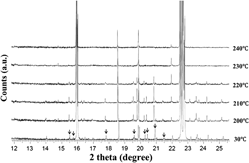Crossref Citations
This article has been cited by the following publications. This list is generated based on data provided by
Crossref.
Zeng, Guang
McDonald, Stuart D.
Gu, Qinfen
Suenaga, Shoichi
Zhang, Yong
Chen, Jianghua
and
Nogita, Kazuhiro
2013.
Phase stability and thermal expansion behavior of Cu6Sn5 intermetallics doped with Zn, Au and In.
Intermetallics,
Vol. 43,
Issue. ,
p.
85.
McDonald, Stuart
Nogita, Kazuhiro
Read, Jonathan
Ventura, Tina
and
Nishimura, Tetsuro
2013.
Influence of Composition on the Morphology of Primary Cu6Sn5 in Sn-4Cu Alloys.
Journal of Electronic Materials,
Vol. 42,
Issue. 2,
p.
256.
Zeng, Guang
McDonald, Stuart D.
Read, Jonathan J.
Gu, Qinfen
and
Nogita, Kazuhiro
2014.
Kinetics of the polymorphic phase transformation of Cu6Sn5.
Acta Materialia,
Vol. 69,
Issue. ,
p.
135.
Chen, Wei-Yu
Tu, Wei
Chang, Hsiang-Ching
Chou, Tzu-Ting
and
Duh, Jenq-Gong
2014.
Growth orientation of Cu–Sn IMC in Cu/Sn–3.5Ag/Cu– x Zn microbumps and Zn-doped solder joints.
Materials Letters,
Vol. 134,
Issue. ,
p.
184.
Zeng, Guang
McDonald, Stuart D.
Gourlay, Christopher M.
Uesugi, Kentaro
Terada, Yasuko
Yasuda, Hideyuki
and
Nogita, Kazuhiro
2014.
Solidification of Sn-0.7Cu-0.15Zn Solder: In Situ Observation.
Metallurgical and Materials Transactions A,
Vol. 45,
Issue. 2,
p.
918.
Chen, Shanxing
Zhou, Wei
and
Wu, Ping
2014.
The structural, elastic, electronic and thermodynamic properties of hexagonal η-Cu6−xNixSn5 (x = 0, 0.5, 1, 1.5 and 2) intermetallic compounds.
Intermetallics,
Vol. 54,
Issue. ,
p.
187.
Chen, Shanxing
Zhou, Wei
and
Wu, Ping
2015.
Effect of Zn Additions on the Mechanical Properties of Cu6Sn5-Based IMCs: Theoretical and Experimental Investigations.
Journal of Electronic Materials,
Vol. 44,
Issue. 10,
p.
3920.
Zeng, Guang
McDonald, Stuart D.
Gu, Qinfen
Terada, Yasuko
Uesugi, Kentaro
Yasuda, Hideyuki
and
Nogita, Kazuhiro
2015.
The influence of Ni and Zn additions on microstructure and phase transformations in Sn–0.7Cu/Cu solder joints.
Acta Materialia,
Vol. 83,
Issue. ,
p.
357.
Zhang, Yong
Yuan, Ding-Wang
Chen, Jiang-Hua
Zeng, Guang
Fan, Tou-Wen
Liu, Zi-Ran
Wu, Cui-Lan
and
Liu, Ling-Hong
2016.
Alloying Effects on the Phase Stability and Mechanical Properties of Doped Cu-Sn IMCs: A First-Principle Study.
Journal of Electronic Materials,
Vol. 45,
Issue. 8,
p.
4018.
Mu, D.K.
McDonald, S.D.
Read, J.
Huang, H.
and
Nogita, K.
2016.
Critical properties of Cu 6 Sn 5 in electronic devices: Recent progress and a review.
Current Opinion in Solid State and Materials Science,
Vol. 20,
Issue. 2,
p.
55.
Zeng, Guang
McDonald, Stuart D.
Mu, Dekui
Terada, Yasuko
Yasuda, Hideyuki
Gu, Qinfen
Salleh, M.A.A. Mohd
and
Nogita, Kazuhiro
2016.
The influence of ageing on the stabilisation of interfacial (Cu,Ni)6(Sn,Zn)5 and (Cu,Au,Ni)6Sn5 intermetallics in Pb-free Ball Grid Array (BGA) solder joints.
Journal of Alloys and Compounds,
Vol. 685,
Issue. ,
p.
471.
Chen, Wei-Yu
Song, Rui-Wen
and
Duh, Jenq-Gong
2017.
Grain structure modification of Cu-Sn IMCs by applying Cu-Zn UBM on transient liquid-phase bonding in novel 3D-IC technologies.
Intermetallics,
Vol. 85,
Issue. ,
p.
170.
Somidin, Flora
Maeno, Hiroshi
Tran, Xuan Quy
D. McDonald, Stuart
Mohd Salleh, Mohd Arif Anuar
Matsumura, Syo
and
Nogita, Kazuhiro
2018.
Imaging the Polymorphic Transformation in a Single Cu6Sn5 Grain in a Solder Joint.
Materials,
Vol. 11,
Issue. 11,
p.
2229.
Somidin, Flora
Maeno, Hiroshi
Mohd Salleh, M.A.A.
Tran, Xuan Quy
McDonald, Stuart D.
Matsumura, Syo
and
Nogita, Kazuhiro
2018.
Characterising the polymorphic phase transformation at a localised point on a Cu6Sn5 grain.
Materials Characterization,
Vol. 138,
Issue. ,
p.
113.
Wu, J.Y.
Chiu, Y.S.
Wang, Y.W.
and
Kao, C.R.
2019.
Mechanical characterizations of single-crystalline (Cu, Ni)6Sn5 through uniaxial micro-compression.
Materials Science and Engineering: A,
Vol. 753,
Issue. ,
p.
22.
Kotadia, H. R.
Mannan, S. H.
and
Das, A.
2019.
Influence of Zn Concentration on Interfacial Intermetallics During Liquid and Solid State Reaction of Hypo and Hypereutectic Sn-Zn Solder Alloys.
Journal of Electronic Materials,
Vol. 48,
Issue. 5,
p.
2731.
Somidin, Flora
Maeno, Hiroshi
Toriyama, Takaaki
McDonald, Stuart D.
Yang, Wenhui
Matsumura, Syo
and
Nogita, Kazuhiro
2020.
Direct observation of the Ni stabilising effect in interfacial (Cu,Ni)6Sn5 intermetallic compounds.
Materialia,
Vol. 9,
Issue. ,
p.
100530.
Zhang, Z.H.
Wei, C.W.
Han, J.J.
Cao, H.J.
Chen, H.T.
and
Li, M.Y.
2020.
Growth evolution and formation mechanism of η′-Cu6Sn5 whiskers on η-Cu6Sn5 intermetallics during room-temperature ageing.
Acta Materialia,
Vol. 183,
Issue. ,
p.
340.
Wu, Zih-You
Wang, Tzu-Chia
Wang, Yu-Ching
Song, Rui-Wen
Tsai, Su-Yueh
and
Duh, Jenq-Gong
2022.
Enhancing mechanical properties via adding Ni and Zn in Cu/Sn3.5Ag/Cu transient liquid phase bonding for advanced electronic packaging.
Journal of Materials Science: Materials in Electronics,
Vol. 33,
Issue. 6,
p.
3016.
Zeng, Guang
Liu, Shiqian
Gu, Qinfen
Zheng, Zebang
Yasuda, Hideyuki
McDonald, Stuart D.
and
Nogita, Kazuhiro
2022.
Investigation on the Solidification and Phase Transformation in Pb-Free Solders Using In Situ Synchrotron Radiography and Diffraction: A Review.
Acta Metallurgica Sinica (English Letters),
Vol. 35,
Issue. 1,
p.
49.





